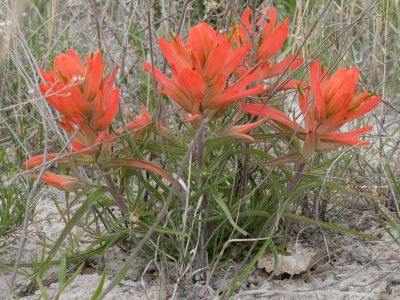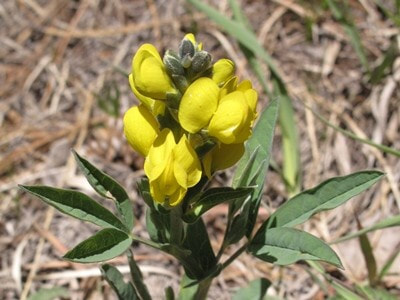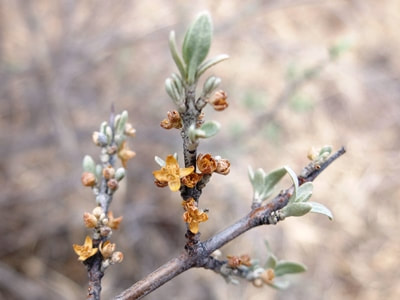|
The Bloom Blog Blooming this week in the environs of Abiquiú By Wildflowers of the Southern Rocky Mountains Found in piñon-juniper and Ponderosa woodlands
Seen blooming in May in Red Wash Canyon This is one of several species of Indian Paintbrush that grow in our area. Orange Paintbrush can grow to 20 inches tall, typically less, with long, purplish-green, rolled leaves and hairy stems. What appears to be flowers, the paintbrush, are actually modified leaves, bracts. The flowers are a narrow, greenish tube protruding beyond the bracts. The flower heads are red to orange to salmon. Native Americans found different uses for the plant; root bark was used with minerals to color deer skin black, dried bracts were mixed with chile seeds to prevent spoilage during storage, the plant was held by women for decoration during the harvest dance, a poultice of leaves was used to dress burns, a decoction of the leaf was taken during pregnancy to keep the baby small, for easy labor. Source. Read more about the Legend and Uses of Indian Paintbrush. If you are trying to identify a different flower then you can check what other flowers bloom this month. If you cannot identify a flower from the website, send a photo and where you took it to [email protected]. Read online for tips.
0 Comments
Golden Pea, Prairie Golden Banner, Golden Bean, Thermopsis rhombifolia, Pea Family (Fabaceae)5/10/2024 The Bloom Blog Blooming this week in the environs of Abiquiú By Wildflowers of the Southern Rocky Mountains Found in sandy areas in ponderosa pine and aspen forests
Seen blooming in May in Bandelier National Monument Growing in large patches, these stout plants grow to 18 inches and have stalks covered in hairs. With leaves consisting of 3 leaflets, the flowers are a bright yellow and form clusters resembling a lupine. The fruit is a greyish-brown, hairy, curved pod. Blooming in early May through June, the Golden Pea is a source of nectar for butterflies, a food source for caterpillars and they provide pollen for bees. Flowers and seeds are poisonous and should not be eaten. The Golden Pea has cultural significance to Native Americans. It is also known by other names, such as the Buffalo Bean and wudzi-eh-ka, meaning buffalo-flower, by the Blackfoot, because they bloom in spring during the time when the buffalo leave their wintering grounds and go out on the prairies. When brewed as a tea, the Golden Pea has been used to treat stomach diseases in both humans and horses. It is also used as a yellow dye. Source. If you are trying to identify a different flower then you can check what other flowers bloom this month. If you cannot identify a flower from the website, send a photo and where you took it to [email protected]. Read online for tips. Chokecherry, Western Chokecherry, Virginia Bird-cherry,Prunus virginiana,Rose Family (Rosaceae)4/29/2024 The Bloom Blog Blooming this week in the environs of Abiquiú By Wildflowers of the Southern Rocky Mountains Found in open woodlands
Seen blooming in May in Abiquiu Chokecherry is a native, deciduous, woody, thicket-forming, large shrub or small tree, rarely reaching 30 feet tall. It can be erect or straggling, dependent on moisture and site. Leaves are oval, often widest above the middle, with fine, sharp teeth. Bark is smooth, reddish-grey to greyish-brown with small, raised, horizontal slits, called lenticels. The aromatic flowers grow in long clusters over four inches long. Chokecherry fruit is pea-sized, dark red to black in color and is bitter, but excellent for syrup, jam or jelly with lots of added sugar. The stones are toxic due to production of hydrocyanic acid. Many wildlife animals eat the fruit and distribute it; birds, rabbits, hares, rodents and bears all seek out and eat its fruit. For many Native American tribes chokecherries are the most important fruit in their traditional diets and are part of pemmican, a staple traditional food. The bark of chokecherry root is used to ward off or treat colds, fever and stomach maladies. The inner bark of the chokecherry is also used by some tribes in ceremonial smoking mixtures, known as kinnikinnick. Source. If you trying to identify a different flower then you can check what other flowers bloom this month. If you cannot identify a flower from the website send a photo and where you took it to [email protected]. Read online for tips. The Bloom Blog Blooming this week in the environs of Abiquiú By Wildflowers of the Southern Rocky Mountains Found in moist areas, stream sides
Seen blooming in April by the Rio Chama Silver Buffaloberry is a native shrub growing to 15 feet tall in thickets. The silvery leaves, habitat and thorny stems cause it to be mistaken for Russian Olive, which is an invasive species. Several things differentiate them; leaves grow in opposite pairs while the leaves of the Russian Olive are alternate, flowers of the Russian Olive are much larger, brighter yellow, tubular and bloom later, the fruit is a red or gold berry while the Russian Olive produces “olives” covered with silvery scale, and the Russian Olive can grow to 35 feet tall. Male and female flowers are produced on separate plants. The tiny yellowish-brown flowers cluster on the stems. The photo is of male flowers. The fruits are an important source of food for birds and animals and are edible for humans, but tart. Native Americans consumed fruits both fresh and dried. Fruits were eaten as a laxative and for stomach troubles and fevers. Fruits were used occasionally in ceremonial feasts at female puberty rites and to make a red dye. Source. If you are trying to identify a different flower then you can check what other flowers bloom this month. If you cannot identify a flower from the website, send a photo and where you took it to [email protected]. Read online for tips. Found in sandy, dry areas
Photo taken in April in Red Wash Canyon The Astragalus genus is very large and individual species are usually identified by their seed pod rather than their flower or leaves; several varieties of Milkvetch grow in this area. This beautiful little plant grows low to the ground with five to eleven silky leaflets. Flowers are showy, bright pink/purple with a lighter center and are over one inch long. Seed pods are curved and covered in silky, white hairs. Specific uses for this species are unknown, but other species in the genus have uses. The plant is considered poisonous, especially to stock and horses, however medicinally; a decoction of whole plant used as a wash for the head, hair and whole body, plant used for stomach disorders, as a gargle for sore throats, poultice of crushed leaves applied to lame back, applied as an ointment for animals with urination troubles, roots chewed as a cathartic, infusion of root used as a wash for sores and as a wash for granulated eyelids and toothaches, also plants used as a ceremonial emetic, seeds used for food, and pounded seeds mixed with other foods and used as a spice. Source. If you trying to identify a different flower then you can check what other flowers bloom this month. If you cannot identify a flower from the website, send a photo and where you took it to [email protected]. Read online for tips. |
AuthorI am Marilyn Phillips, a native of England, whose love of nature and the outdoors from childhood brought me by a circuitous route to Crested Butte, Colorado in 1993 and 16 years later to northern New Mexico. My exploration of the many trails in these areas, my interest in wildflowers and photography, and career in computer system design came together in this creation. If you have any corrections, comments or questions, please contact me by email. Archives
September 2025
Categoriescopyright © 2020
|







 RSS Feed
RSS Feed